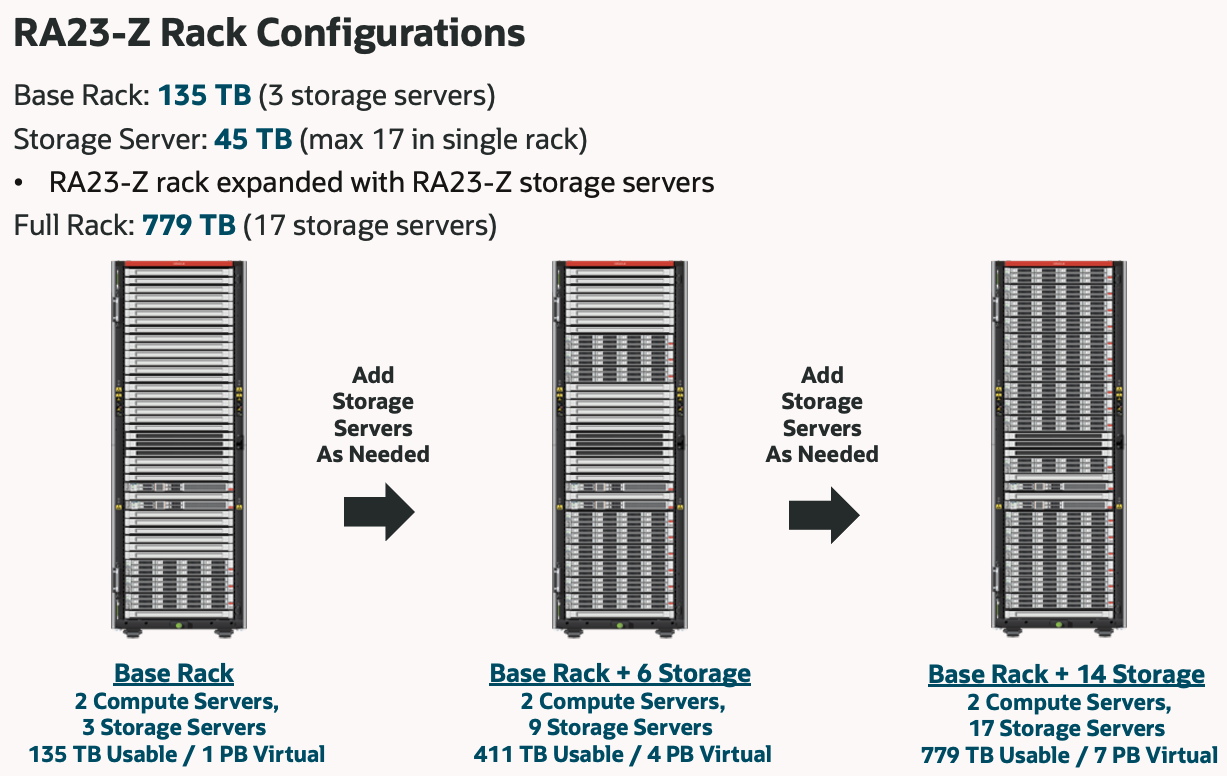We are excited to announce the immediate availability of two new cost-optimized offerings: the Exadata X11M eXTended (XT) Storage Server, and the Zero Data Loss Recovery Appliance RA23-Z. While each serves a different purpose, both give customers more flexibility for running and protecting databases cost-effectively with exclusive Oracle capabilities. Customers now have more options for deploying Oracle Database on Exadata and protecting those databases with the Zero Data Loss Recovery Appliance.
Let’s look at what’s new.
The all-new Exadata X11M eXTended (XT) storage server
The new X11M XT storage servers are built for infrequently accessed data, such as online data archives, and for development or test databases with lower performance requirements. They deliver the efficiency, performance, and innovation you expect from Exadata while providing cost-effective additional storage capacity.

X11M XT storage provides cost-effective, scalable storage for data that is accessed less often but must stay online for retention or compliance, as well as for databases with lower performance needs. This is the first XT storage generation to support both Exascale and ASM. X11M XT can be shared among multiple database clusters and quickly expand storage for all your databases. This generation of XT introduces significant new technical capabilities. It can also expand the capacity of X8M, X9M, or X10M XT storage, allowing seamless growth for existing and new Exadata deployments.
What’s inside the X11M eXTended Storage Server?
- 1x the latest 32-core AMD EPYC processor
- 256 GB DDR5 memory for Exadata System Software
- 2x 6.8 TB performance-optimized flash cards for Exadata Smart Flash Cache
- 12x 22 TB hard disks for data persistence
The X11M XT storage server is the first generation of XT server to include flash for Exadata Smart Flash Cache! Flash cache in XT storage uses two 6.8 TB performance-optimized flash cards, the same cards found in the Extreme Flash (EF), High Capacity (HC), and High Capacity-Z (HC-Z) servers, and automatically caches the hottest data in flash. This avoids I/O requests to the hard disks and delivers 600,000 OLTP read and 500,000 OLTP write IOPS. In addition, OLTP workloads benefit from the significantly lower read latency of flash. Flash cache can also be used to accelerate analytic workloads by optionally purchasing licenses for Exadata System Software and enabling Smart Scan. When enabled, Smart Scan can deliver up to 50 GB/s SQL scan throughput for analytic workloads.
X11M XT storage servers are the first generation of XT storage designed for Exadata Exascale, the next-generation, data-intelligent architecture for Exadata. Exascale reimagines how compute and storage resources are managed in Exadata by decoupling storage management from the database servers and paving the way for powerful new snapshot and cloning features. Exascale enables space-efficient thin clones from any read/write pluggable and container database, which significantly boosts developer productivity.
Hybrid Columnar Compression is included with X11M XT, as in previous generations, simplifying in-database archiving and increasing cost efficiency. XT storage works seamlessly with Information Lifecycle Management (ILM) strategies, such as those automated by the Automatic Data Optimization (ADO) capability in Oracle Database. ADO automatically and transparently moves data to lower-cost storage as the data ages within the database. At the same time, ADO can implement different compression levels based on the data’s age and access frequency, further increasing the cost efficiency of XT storage. With X11M XT storage and the flexibility to mix EF, HC, and HC-Z servers, you always have the right resources and performance for your environment.
By making the Exadata System Software licenses optional for the X11M XT Storage Server, customers can add new X11M XT storage servers to create an XT storage pool for Exascale or XTND diskgroup for ASM, for a list price that’s 76% lower than the standard HC storage servers, which require Exadata System Software licenses.
You can integrate X11M XT storage into an Exadata system easily with Oracle Exadata Deployment Assistant (OEDA). Use OEDA to:
- Create an XT storage pool alongside existing EF or HC storage pools
- Extend or create XTND ASM disk groups for database clusters
- Enable a hybrid deployment that combines Exascale and ASM on the same XT servers
Minimum requirements
X11M XT storage servers require Exadata System Software 25ai, release 25.2.0 (released in July 2025) or newer.
Introducing Zero Data Loss Recovery Appliance RA23-Z: Cost-optimized, entry-level system for next-generation intelligent database protection
We are also announcing the immediate availability of the RA23-Z, a new Engineered System designed for small to medium-sized Oracle customers to protect environments with a collective size of databases of 100 TB or less. The RA23-Z can also be leveraged by larger customers to experience the full range of Recovery Appliance’s innovative capabilities in a smaller environment, before moving to the RA23 for wider usage. These include:
- Zero data loss protection against ransomware attacks and outages
- Zero-impact data anomaly detection to prevent malicious data encryption and corruptions from impacting recovery
- High performance, incremental forever backup to offload production server and network resource utilization
- Fast recovery to new production environment or clean room with database-integrated virtualized full backups
Finally, the RA23-Z can provide a cost-optimized path for customers with more restrictive budgets that need to deploy systems across multiple sites, including production, DR, cyber vault, and clean room locations. Multi-site environments are increasingly being mandated by regulatory and cyber data resilience requirements.
System configuration and pricing
The RA23-Z base rack consists of 2x RA23 compute servers and 3x RA23-Z storage servers, providing 135 TB usable backup capacity, suitable for protecting database environments of 100 TB or less. The new RA23-Z storage server has 6x 22 TB disk drives offering 45 TB backup capacity, as compared with 12x 22 TB disk drives in the RA23 storage server, which offers 90 TB backup capacity.
The base rack can be expanded with RA23-Z storage servers to a maximum of 17 storage servers, supporting 779 TB capacity in a single rack, as shown below.

By reducing the number of disk drives, the RA23-Z base rack is list priced at 30% lower than the RA23 base rack, while the RA23-Z storage server is list priced at 36% lower than the RA23 storage server.
These new price points make RA23-Z a highly compelling entry point system for small to medium-sized customers, while offering the full set of Recovery Appliance database-engineered protection and recovery capabilities.
Minimum requirements
The RA23-Z requires minimum software versions as follows:
- ZDLRA software version: 23.1.202506-RELEASE (June PSU)
- Exadata System Software version: 25.1.6.0.0 or 25.2.0.0.0
Additional information
Learn about Oracle Exadata Database Machine and the X11M family, including X11M XT at https://www.oracle.com/engineered-systems/exadata/ and the following resources:
For Recovery Appliance and RA23-Z, see the product data sheet and documentation at: https://oracle.com/zdlra. Also, check out the following resources:
- Oracle Database Protection & Ransomware Resiliency Central: Learn more about our complete suite of solutions built by Oracle for Oracle databases, including Oracle Database Security, Recovery Appliance, and Autonomous Recovery Service.
- Oracle Backup and Recovery Technologies blog and AskTOM Live sessions: Keep up to date with the latest news and product updates for Oracle’s data protection and recovery solutions.
Download the latest configuration and deployment assistants here:
Final thoughts
With the introduction of Exadata X11M eXTended (XT) Storage Server and Zero Data Loss Recovery Appliance RA23-Z, Oracle is expanding its engineered systems portfolio to deliver more cost-effective, capacity-optimized storage and advanced, affordable data protection. These options give customers greater flexibility for managing Oracle Database workloads, whether that means optimizing storage for less frequently accessed data or ensuring seamless data protection and recovery for databases of all sizes. By supporting new deployment models and tighter budgets, while maintaining best-in-class performance, scalability, and security, Oracle continues to help organizations grow and safeguard their data with confidence.

